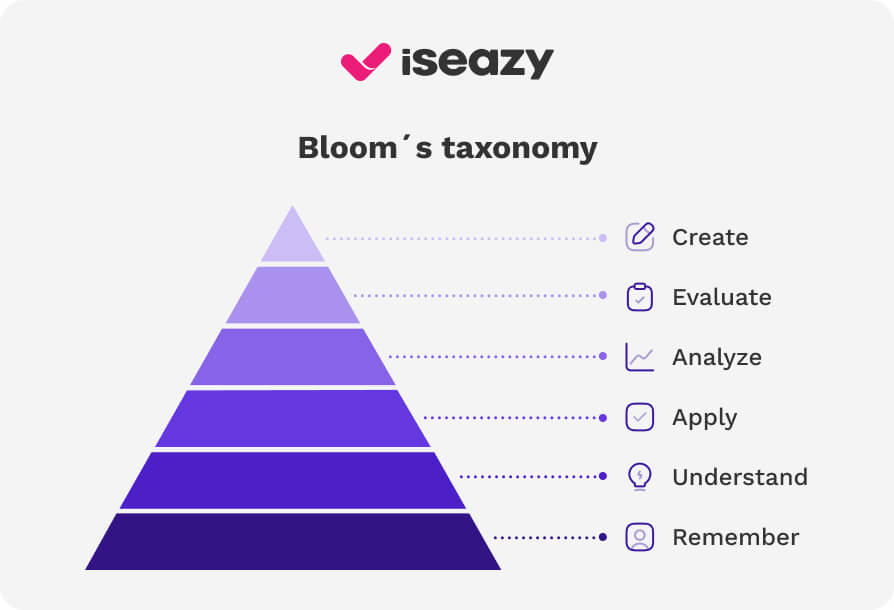WHITEPAPER
Looking for the perfect tool to create interactive courses? Here's how to choose it

November 13, 2025
CONTENT CREATED BY:

Table of contents
Understanding how we learn is crucial for developing effective training programs in the corporate world. Bloom’s Taxonomy serves as a foundational framework that categorizes learning objectives into levels of complexity and specificity. In this post, we will explore the key concepts of Bloom’s Taxonomy, its practical applications in corporate training, and how to leverage it to enhance employee learning and development.
Bloom’s Taxonomy was introduced in 1956 by a group of educational psychologists led by Benjamin Bloom. It provides a structured approach to categorizing educational goals and fostering higher-order thinking. As organizations increasingly recognize the importance of continuous learning and skill development, Bloom’s Taxonomy continues to resonate in the realm of corporate training. Its relevance lies in its ability to guide trainers in creating effective and comprehensive learning experiences.
Originally developed to aid educators in designing curricula, Bloom’s Taxonomy has evolved through various iterations. The first version categorized cognitive skills into six major categories: Knowledge, Comprehension, Application, Analysis, Synthesis, and Evaluation. In 2001, a revised version was introduced that rephrased the categories into verbs: Remember, Understand, Apply, Analyze, Evaluate, and Create. This evolution reflects the changing needs of learners and pedagogical practices, making it applicable to contemporary corporate training.
With the rapid advancement of technology and the shifting landscape of work, having a framework that aligns educational objectives with real-world skills is essential. Bloom’s Taxonomy remains relevant as it fosters critical thinking, helps in designing clear learning objectives, and supports a sequence of learning that gradually builds complex skill sets. By implementing this taxonomy, corporate trainers can enhance the effectiveness of their training programs, resulting in improved employee performance and competency.
In the cognitive domain, there are six levels of learning that form a hierarchy. Each level builds upon the previous one, creating a solid foundation for deeper learning experiences.
At the lowest level, Remembering involves recalling facts and basic concepts. This foundational step is crucial for all subsequent learning and can include activities such as quizzes or flashcards that encourage memory recall.
The next level, Understanding, requires learners to demonstrate comprehension of the material. This can take the form of summarizing information, explaining concepts to others, or interpreting data. Using e-learning tools like isEazy Author, trainers can create interactive modules that engage learners in understanding course content.
Applying knowledge means turning theory into action — it’s where learning comes to life. One of the most effective ways to do this is through branching scenarios: interactive experiences that place learners at the heart of decision-making. Built with isEazy Author, these simulations allow users to explore different paths, make decisions in realistic contexts, and see the outcomes of their choices. The result? More engaging, hands-on training that’s directly tied to real workplace challenges. Want to learn how to create this kind of experience in your e-learning course? Check out our article to know more about it.

At the Analyzing level, learners break down information into parts and explore relationships. Training programs can implement case studies and analysis projects to assess how well employees can interpret data and derive conclusions, encouraging critical thinking necessary for informed decision-making.
The Evaluate stage requires learners to make judgments about information, ideas, or materials. Incorporating peer review sessions or critique exercises can enhance these skills. This level is pertinent for leadership roles where decision-making under pressure is essential.
Finally, the highest order of thinking, Creating, involves developing new ideas or products. This level encourages innovation and problem-solving, which are essential in a competitive corporate environment. Activities like project-based learning, where employees can design solutions to real business challenges, foster creativity.

Before diving into specific examples, it’s important to understand how to effectively apply Bloom’s Taxonomy in your training programs. Here are some strategies to consider:
To effectively apply Bloom’s Taxonomy, it is crucial to craft clear learning objectives that align with each cognitive level. Each objective should start with an action verb that denotes the expected outcome. For instance, “By the end of this course, participants will be able to analyze sales data to predict future trends.”
When designing training programs, consider sequencing activities that progress from lower-order thinking skills to higher-order skills. This scaffolding approach ensures that learners have a solid foundation before tackling more complex concepts and challenges.
Bloom’s Taxonomy offers numerous advantages to corporate training initiatives, especially when aiming to develop a highly skilled workforce.
By constructing learning pathways that activate different cognitive levels, trainers can significantly enhance engagement. Interactive activities, relevant content, and clear objectives lead to improved retention of information.
Bloom’s Taxonomy encourages a structured approach to developing critical thinking. By integrating higher-order thinking skills into training, organizations cultivate employees who can navigate complex problems innovatively.
Utilizing Bloom’s Taxonomy enables trainers to tailor learning experiences to individual employee needs and competencies. This adaptability fosters a culture of continuous learning, ultimately driving business success.
Digital learning platforms, such as isEazy LMS, provide the tools necessary for implementing Bloom’s Taxonomy effectively. These platforms can help streamline curriculum development and training administration, ensuring that learners progress through cognitive levels at their own pace.
Artificial intelligence plays a key role in simplifying the instructional design process while elevating the quality of learning experiences. With isEazy Author, trainers can rely on AI-powered features — like automatic generation of final tests, interactive exercises, and even voice-overs — to design content tailored to different levels of Bloom’s Taxonomy. This makes it easier to align each learning objective with the right type of activity, whether it’s recalling facts, applying concepts, or evaluating outcomes. The result: faster course creation and more effective, personalized training — without the need for technical expertise.

Establishing clear Key Performance Indicators (KPIs) is essential for measuring the success of training initiatives. Metrics may include completion rates, learner satisfaction surveys, and knowledge retention tests.
Employing data analytics is crucial for tracking learner experiences and outcomes. By analyzing data, organizations can adjust their training methods and assess whether objectives aligned with Bloom’s levels are being met effectively.
Ultimately, the goal of applying Bloom’s Taxonomy in corporate training is to foster a workforce that can contribute to overall business objectives. By linking learning outcomes to performance metrics, companies can better ascertain the ROI of their training programs.
When creating training sessions, prioritize defining clear, actionable learning objectives. Ensure these objectives are measurable so that you can accurately gauge the effectiveness of your sessions.
Different learning levels require varied assessment techniques. Utilize quizzes for Remembering, essays for Understanding, and projects for Creating to ensure a comprehensive evaluation of learner grasp.
Regularly review training content and methodologies to enhance effectiveness. Use feedback from learners and analytics to make necessary adjustments and ensure the training remains relevant and impactful.
Bloom’s Taxonomy offers more than just a framework — it’s a powerful guide for designing corporate training that drives real behavioral change and business impact. When supported by digital tools, this model helps create structured, engaging, and practical learning experiences that progress from understanding to application and innovation. With isEazy Author and isEazy LMS, organizations can bring Bloom’s principles to life through intuitive course creation, impactful content, and seamless training management.
Ready to transform the way your teams learn? Request a demo and see how isEazy can help you build smarter, more effective training programs.
Bloom’s Taxonomy is a framework that categorizes learning objectives into six cognitive levels: Remember, Understand, Apply, Analyze, Evaluate, and Create. It helps corporate trainers design structured learning experiences that promote deeper understanding, critical thinking, and real-world application—making training more effective and impactful.
By guiding the progression from basic knowledge to complex problem-solving, Bloom’s Taxonomy ensures that employees not only retain information but also apply it in practical scenarios. This structured approach develops competencies such as decision-making, innovation, and analytical thinking, directly enhancing on-the-job performance.
Digital tools streamline the application of Bloom’s Taxonomy. With isEazy Author, you can create interactive content and branching scenarios that map to different cognitive levels. isEazy LMS supports learning paths, progress tracking, and data analytics to ensure learners move through the taxonomy effectively and at their own pace.
With the new interactive: branching scenarios in isEazy Author.
Try it freeRequest a demo



